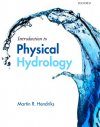![Introduction to Physical Hydrology Introduction to Physical Hydrology]()
Click to have a closer look
About this book
Contents
Customer reviews
Related titles
About this book
Water dominates our lives: we live on a planet with much water and our lives depend on it in many ways. Despite the seeming abundance of water on the planet human activity and prevailing climate conditions are placing more pressure on our supply of water than ever before. With this pressure comes a need to understand the physical principles of hydrology, an understanding that can then be applied to water management and related innovations.
Introduction to Physical Hydrology provides a solid grounding in the principles of the subject. Exploring the principal rules that govern the flow of water on the land it considers the three major types of water: atmospheric, ground, and soil. It gives insights into the major hydrological processes and shows how the principles of physical hydrology inform our understanding of climate and global hydrology - the large scale study of hydrology with which we need to grapple to fully understand the impact of the climate on water supply.
The study of physical properties is done most effectively through mathematical representations of concepts and processes. Introduction to Physical Hydrology includes a carefully-developed and class-tested learning framework: an extensive range of examples and exercises, and further maths support in the form of a series of Maths Toolboxes help the reader engage with and understand the maths required to master the subject.
Contents
1: INTRODUCTION; 1.1 Major water types; 1.2 Hydrological cycle; 1.3 Drainage basin hydrological processes; 1.4 Water balance; 2: ATMOSPHERIC WATER; 2.1 Cloud formation; 2.2 Generation of precipitation; 2.3 Precipitation types; 2.4 Measuring precipitation; 2.5 Areal precipitation; 2.6 Evaporation types and measurement; 2.7 Estimating evaporation: Penman-Monteith; 3: GROUNDWATER; 3.1 Misconceptions; 3.2 Drilling a hole; 3.3 Bernoulli to the aid; 3.4 Aqui; 3.5 Effective infiltration velocity and infiltration rate; 3.6 The soil as a wet sponge; 3.7 Brothers in science: Darcy and Ohm; 3.8 Refracting the water; 3.9 Keep it simple and confined; 3.10 Continuity and its consequences; 3.11 Going Dutch; 3.12 Flow nets; 3.13 Groundwater flow regimes and systems; 3.14 Fresh and saline: Ghijben-Herzberg; 3.15 Groundwater hydraulics; 4: SOIL WATER; 4.1 Negative water pressures; 4.2 Determining the total potential; 4.3 The soil as dry filter paper or a wet sponge; 4.4 The soil moisture characteristic; 4.5 Drying and wetting: hysteresis; 4.6 Unsaturated water flow; 4.7 Moving up: capillary rise and evaporation; 4.8 Moving down: infiltration and percolation; 4.9 Preferential flow; 5: SURFACE WATER; 5.1 Bernoulli revisited; 5.2 Measuring stage, water velocity and discharge; 5.3 Hydrograph analysis; 5.4 Conceptual rainfall-runoff models; 5.5 Variable source area hydrology; A ALTERNATIVE HYDROLOGICAL TERMS; B BOXES INVENTORY; C CONCEPTUAL TOOLKIT; D ANSWERS TO THE EXERCISES; M MATHEMATICS TOOLBOXES
Customer Reviews


































